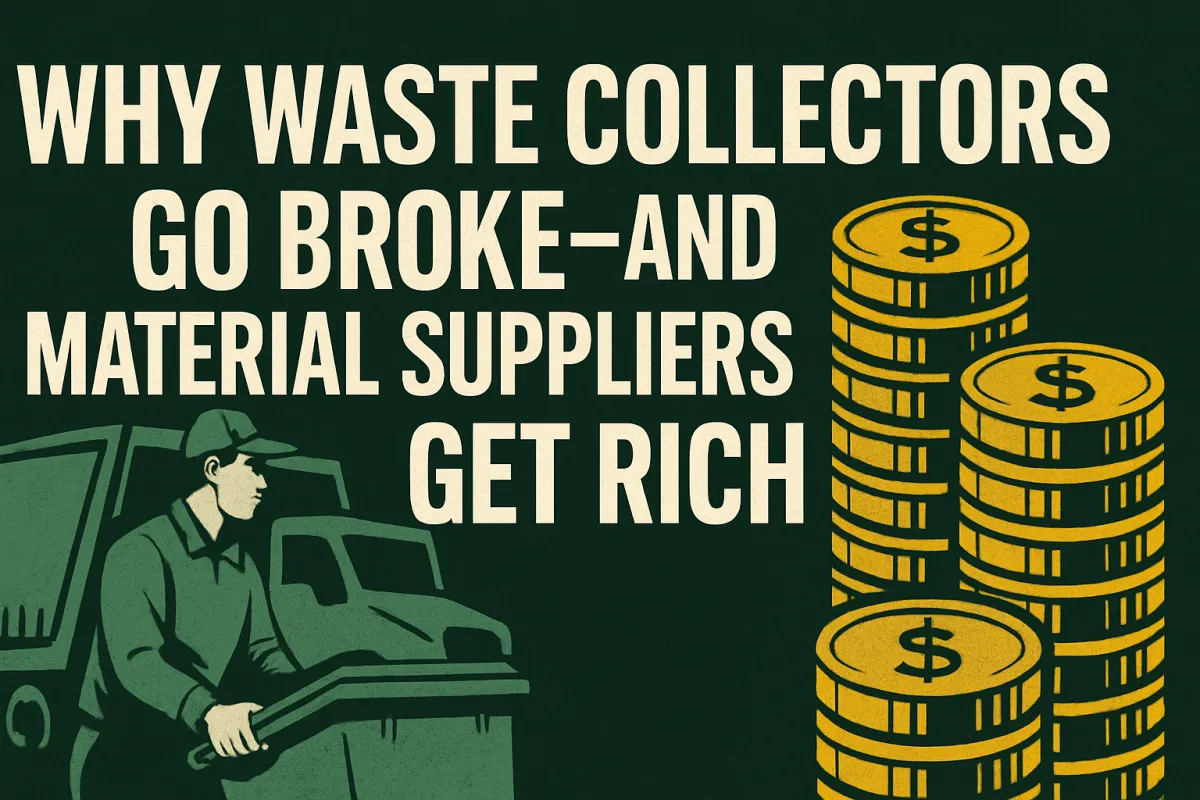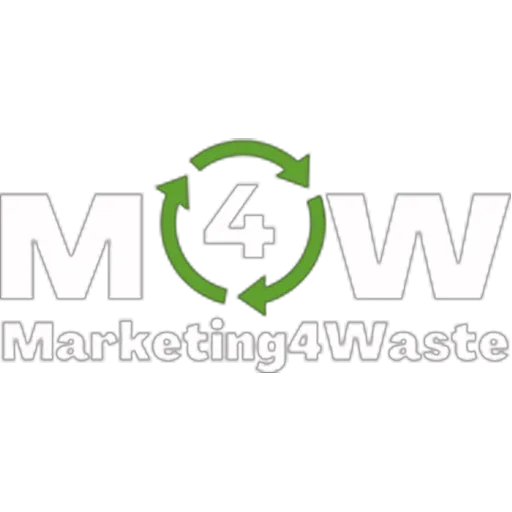Increase the Revenues of Your Waste Company With the Tips Shared in Our Blog Articles

Why Waste Collectors Go Broke—And Material Suppliers Get Rich
Let me be blunt.
If you're still thinking of your business as a "waste collection company" in 2025, you’re sitting on a gold mine without a shovel.
Right now, across the United States, hundreds of waste operators are driving routes, picking up containers, and dumping them off at transfer stations or MRFs, praying for that next contract renewal or rate hike approval.
That’s a losing game. Margins are shrinking. Regulations are multiplying. Tariffs are shaking up the global market. And while you're hauling other people’s trash, smarter operators are flipping the model and selling what you’re throwing away.
Let me show you how to do the same—and why this mindset shift is the key to unlocking a new level of revenue, growth, and strategic power.
👉 [Download the Guide “The US-China Tariff War”]
THE OLD MODEL IS DEAD: "TONNAGE IN, TONNAGE OUT"
If you’re still in the "get paid per ton" mindset, here’s what your future looks like:
Increasing disposal fees
Rising fuel and labor costs
Cities grinding you down for lower prices
And zero control over what happens once the waste leaves your facility
You’ve become a logistics company disguised as a waste company. And logistics companies get commoditized. You’re not building an asset—you’re just running trucks.
Now, imagine instead of charging $150 per ton to pick up waste, you were selling $400-per-ton plastic resin, $1,500-per-ton cardboard bales, or $6,000-per-ton copper from shredded WEEE.
That’s not a dream. That’s what happens when you stop thinking like a waste collector and start thinking like a material supplier.
👉 [Download the Guide “The US-China Tariff War”]
THE MINDSET SHIFT: WASTE ≠ GARBAGE. IT’S INVENTORY.
Here’s the mindset switch that separates the pros from the amateurs:
"I'm not in the waste business. I'm in the raw material supply business."
Every skip, bin, or compactor you pick up isn’t just a container to dump. It’s a source of recoverable value.
And in a world where tariffs, trade wars, and import restrictions are making primary raw materials more expensive, secondary sources are becoming the go-to supply chain for companies trying to cut costs or meet compliance rules.
Think about it. The U.S. is now one of the most sought-after markets for "safe sourcing." Manufacturers are tired of the headaches from Chinese suppliers, and they're under pressure to localize their supply chain. That means:
➡️ They need local suppliers.
➡️ They’re willing to pay more for reliability.
➡️ You could be that supplier.
👉 [Download the Guide “The US-China Tariff War”]
MEET YOUR NEW CUSTOMERS: EPR AND ESG-DRIVEN COMPANIES
Forget the word sustainability. This is about compliance and PR protection.
Big brands are launching Extended Producer Responsibility (EPR) programs. Why? Because lawmakers are forcing them to take responsibility for the end-of-life of their products.
Now they’re scrambling for recycled feedstock. They don’t want to rely on brokers—they want direct access to suppliers with clean, consistent streams of usable material. This is your door in.
You’re no longer a hauler. You’re a material partner.
You don’t wait for a city to sign a service contract. You build direct supply agreements with manufacturers. You talk price per ton. Quality specs. Monthly volumes.
That’s a high-leverage conversation—one most of your competitors can’t even enter.
👉 [Download the Guide “The US-China Tariff War”]
CASE STUDY: FROM PICK-UP CREW TO PROFIT MACHINE
Let me give you a real-world example.
One of my clients—let’s call him Mike—was running a 6-truck operation in the Midwest. Focused on commercial front-loads and construction roll-offs. Business was decent, but every quarter felt like a fight just to maintain margins.
We sat down and reviewed his routes. Turns out, he was collecting tons of corrugated cardboard, stretch film, and food-grade PET bottles from retail clients.
We installed a sorting bay, brought in a baler, and connected him with two regional buyers—one for cardboard, one for PET.
Fast forward 9 months. He’s making $12,000–$18,000/month just from resale. Same routes. Same clients. But now, he’s not getting paid once for hauling trash—he’s getting paid again for selling what was inside.
That's the power of flipping the script.
👉 [Download the Guide “The US-China Tariff War”]
WHAT CHANGES WHEN YOU BECOME A MATERIAL SUPPLIER?
Here’s what happens when you stop thinking like a collector and start acting like a supplier:
✅ You build inventory, not just handle waste.
✅ You create leverage. When disposal rates go up, you don’t flinch—you sell more product.
✅ You attract new clients. Recycling facilities, manufacturers, even exporters want to talk to you.
✅ You increase your company valuation. Investors and buyers pay more for asset-based businesses, not service-only haulers.
And let me be clear: you don’t need a $10 million MRF to start. You need:
A baler or shredder
A clean loading area
Basic sorting staff
And the right mindset
Once you’ve got that, you’re in the game.
👉 [Download the Guide “The US-China Tariff War”]
BUT WHAT ABOUT TARIFFS? HOW DO THEY FIT IN?
Simple: tariffs are a gift—if you know how to use them.
When the U.S. slaps tariffs on aluminum, steel, plastics, or other materials, it doesn’t just hurt importers. It creates a price floor that protects domestic suppliers.
Guess what? That includes you.
If recycled aluminum is trading at $1,200/ton and the tariff raises the cost of imported aluminum to $1,500/ton, you’ve just gained a $300/ton margin edge—without lifting a finger.
Companies will start looking for local alternatives. That’s your moment to step in and say:
“We’ve got a steady stream of clean material. No import headaches. Let’s talk volumes.”
That’s how you win.
👉 [Download the Guide “The US-China Tariff War”]
SO WHAT NOW?
You’ve got two choices.
You can keep running your routes, bidding on low-margin contracts, and praying disposal rates don’t kill your business.
Or you can make the shift.
You can transform from a waste collector to a material supplier.
From a subcontractor to a key player in the raw materials market.
From someone who gets paid once… to someone who gets paid twice.
This shift isn’t theory. It’s real. It’s happening. And the companies making the move now will dominate the next decade of the waste and materials game.
If you're ready to make the switch, I've put together a powerful, no-BS guide that breaks down exactly how the US-China tariff war is shaping your opportunity—and what to do about it.
👉 [Download the Guide “The US-China Tariff War”]
Let’s get to work.
—
Samuele "Sam" Barrili
The Waste Management Alchemist
Helping you turn trash into cash—one strategy at a time.


© 2025 Marketing4waste - All Rights Reserved,
Marketing4Waste is a brand of MiM MarketingInterimManagers LLC
+1 801 804 5730

